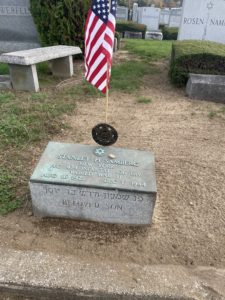By Neal Gosman
Six-year-old Cub Scout Elijah Dale carefully scrutinized the various works on display at the Capp Building of the Jewish Community Center (JCC) at an art exhibit co-sponsored by the JCC and the Jewish War Veterans Department of Minnesota.
“That one is just like the picture on the wall in my Dad’s office,” Dale pointed out. This is not as surprising as it might have been, because the artist is in fact his Dad, Jeffrey Dale, a Saint Paul photographer, coder, and Afghanistan War veteran who served in the U.S. Army for ten years.
More surprising is why the Department of Minnesota is sponsoring the art exhibit that opened on December 11.
Last summer, the department put out a call for artists to present works on the themes, Defending Democracy, Fighting Oppression, and Tzedakah. “This is a pilot project that we haven’t tried before,” explained Department of Minnesota Commander Lou Michaels. “We want to be more present in the community with our dual missions of being a Jewish Voice for Veterans and a Veterans’ Voice for Jews.”
Michaels said he wants to raise the profile of JWV in the community, which will in turn focus attention on the needs of veterans in general and on why they put their lives on the line in service of American ideals.
Jeffrey Dale presented three photos from his series Friday Night, based on his experience in Afghanistan. “I am thrilled to have this opportunity to show some of my work. All too often, the established art world shies away from the soldier’s perspective,” he said.
Other artists showed paintings reflecting empathy with Latin American refugees, honoring the Ukrainian resistance, and there were also posters calling for justice, empowerment, and democracy.
The exhibit also featured a pen and ink drawing by the late Mark Zhitnitsky, a former Soviet and Israeli artist, which illustrates his struggles in 1919 Ukraine against antisemitic pogroms.
“The ultimate aim of this exhibit, hopefully the first of more to come, is to build awareness of the JWV in Minnesota, to grow public support, and to attract new members from among veterans in the Jewish community,” said Stewart Mednick, Department of Minnesota Vice Commander.
Volume 77. Number 1. 2023


